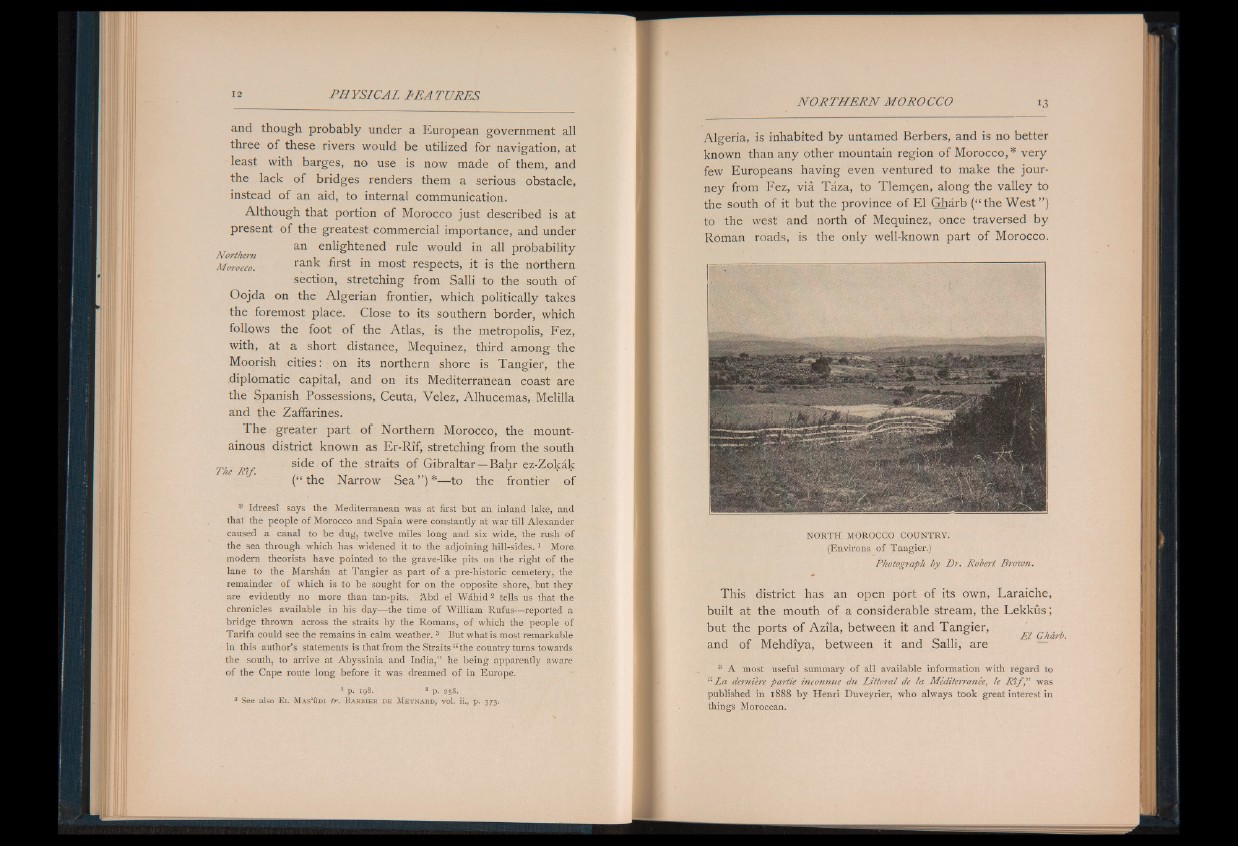
and though probably under a European government all
three o f these rivers would be utilized for navigation, at
least with barges, no use is now made of them, and
the lack o f bridges renders them a serious obstacle,
instead o f an aid, to internal communication.
Although that portion of Morocco just described is at
present o f the greatest commercial importance, and under
„ an enlightened rule would in all probability
Northern \ r , • . . .
Morocco. rank first in most respects, it is the northern
section, stretching from Salli to the south of
Oojda on the Algerian frontier, which politically takes
the foremost place. Close to its southern border, which
follows the foot o f the Atlas, is the metropolis, Fez,
with, at a short distance, Mequinez, third among the
Moorish cities: on its northern shore is Tangier, the
diplomatic capital, and on its Mediterranean coast are
the Spanish Possessions, Ceuta, Velez, Alhucemas, Melilla
and the Zaffarines.
The greater part o f Northern Morocco, the mountainous
district known as Er-Rif, stretching from the south
K . ^ side of the straits of Gibraltar— Bahr ez-Zokak
T h e R t f . , ^ * *
(“ the Narrow S e a ” )*— to the frontier of
* Idreest says the Mediterranean was at first but an inland lake, and
that the people of Morocco and Spain were constantly at war till Alexander
caused a canal to be dug, twelve miles long and six wide, the rush of
the sea through which has widened it to the adjoining hill-sides.1 Mora
modem theorists have pointed to the grave-like pits on the right of the
lane to the Marshal! at Tangier as part of a pre-historic cemetery, the
remainder of which is to be sought for on the opposite shore,, but they
are evidently no more than tan-pits. Abd el Wahid2 tells us that the
chronicles available in his day— the time of William Rufus— reported a
bridge thrown across the straits by the Romans, of which the people of
Tarifa could see the remains in calm weather. 3 But what is most remarkable
in this author’s statements is that from the Straits “ the country turns towards
the south, to arrive at Abyssinia and India,” he being apparently aware
of the Cape route long before it was dreamed of in Europe.
1 p . 198. 2 p . 258.
3 S e e also E l M a s ’ u d i tr. B a r b i e r d e M e y n a r d , vol. ii., p . 373.
N O R TH E RN MOROCCO
Algeria, is inhabited by untamed Berbers, and is no better
known than any other mountain region of Morocco,* very
few Europeans having even ventured to make the journey
from Fez, via Taza, to Tlemgen, along the valley to
the south o f it but the province of El Gharb (“ the W e s t” )
to the west and north of Mequinez, once traversed by
Roman roads, is the only well-known part of Morocco.
NORTH MOROCCO COUNTR Y.
(Environs of Tangier.)
Photograph by Dr. Robert Brown.
This district has an open port of its own, Laraiche,
built at the mouth o f a considerable stream, the Lekkûs ;
but the ports of Azila, between it and Tangier, ' ,
and of Mehdiya, between it and Salli, are
* A most useful summary of all available information with regard to
“ La dernière partie inconnue du Littoral de la Méditerranée, le R ïfJ” was
published in 1888 by Henri Duveyrier, who always took great interest in
things Moroccan.